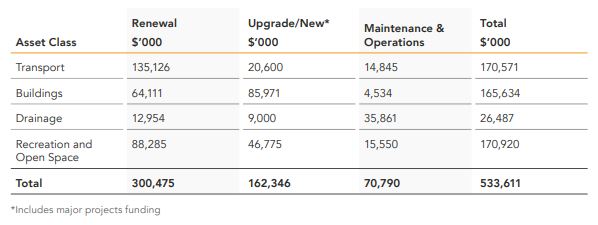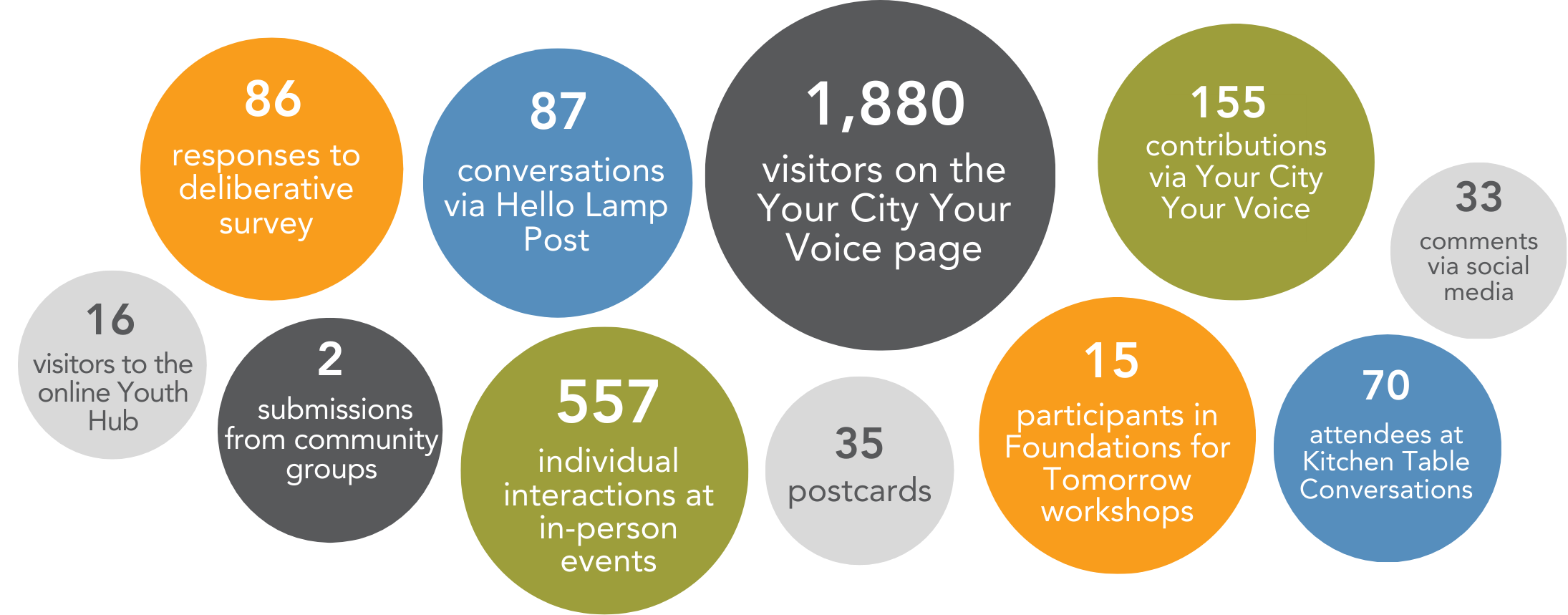You can translate the content of this page by selecting a language in the box below:
Key strategic documents endorsed
The Council Plan 2025-29, the updated Community Vision, the Asset Plan 2025-35, the Financial Plan 2025-35 and the Municipal Public Health and Wellbeing Plan 2025-29 were endorsed at the 19 August 2025 Council Meeting.
Across three phases of engagement from July 2024 to June 2025, more than 2,900 residents engaged on these documents across multiple in-person and online channels, providing over 1,000 individual contributions. This also includes an initial standalone conversation on the Municipal Public Health and Wellbeing Plan in August 2024.
For the most recent conversation in mid-2025 – which involved seeking feedback on the draft Plans – 231 people participated, including:
Overall, there was clear support for the proposed Community Vision, support for the proposed strategic objectives in the draft Council Plan, broad support for the proposed objectives and indicators in the draft Municipal Public Health and Wellbeing Plan, and support for the proposed allocation of funds outlined in the draft Asset Plan.
The endorsed plans, along with the Engagement Summary Report are available in the Document Library.
You can also view the livestream of the 19 August Council Meeting on our website.
Key updates to the documents
Council Plan
Strategic Objectives
The Council Plan 2025-29 guides the planning, development, resourcing and provision of services to the community over a four-year period.
Reviewed annually to consider emerging community needs, the draft Council Plan aims to ensure the organisation remains progressive, dynamic and committed to supporting our community.
The Council Plan is the result of months of planning and deliberation, which included:
- community engagement and feedback
- Councillor and staff planning workshops to identify directions and outcomes
- research and consideration of the City's long-term challenges and opportunities.
Click here to view the endorsed Council Plan.
Council has focused on five strategic objectives over the four-year period which include:
Community Vision
The Community Vision currently sits in the Maribyrnong 2040: Community Plan, which was endorsed in 2018:
During phases one and two of engagement, respondents told us that the current Community Vision is okay but needs some work. As a result, the following refined statement was put forward during the deliberative workshops:
Asset Plan
The Asset Plan guides the efficient and effective management of our assets, such as buildings, roads and drainage systems, through to footpaths, bike paths and parks and ovals, over a 10-year period.
The 60,000 public assets owned and operated across our four asset portfolios (transport, drainage, recreation and open space, and buildings) total over $1.1 billion in replacement costs.
Council takes a lifecycle management approach to asset management planning, considering the resourcing requirements to operate, maintain, rehabilitate and renew assets to meet service level requirements and asset useful life expectancy.
The Asset Plan outlines the state of our assets in terms of asset health by asset class as at 30 June 2024. In comparison to the national average of 66%, the health of our assets are as follows:
- Transport - 74%
- Buildings - 63%
- Drainage - 77%
- Recreation and Open Space - 74%
Asset condition distribution as a percentage of replace cost as of 30 June 2024

10-year expenditure by asset class
The Asset Plan states that investment in asset maintenance and renewal will be balanced by significant investment in new and upgraded assets to meet current and future demand. This includes supporting our increasing population and increased community demand for services.
This level of investment over 10 years will ensure that our assets don’t slip below the national standard.
Given all that we heard, Council is proposing the following asset renewal investment for the next 10 years:

*Includes major projects funding
Click here to view the endorsed Asset Plan.
Financial Plan
The Financial Plan provides the overall financial framework for our strategic planning, financial guidance to Council and senior management in setting budgets, preparing operational plans, capital works planning and service planning.
The Financial Plan is based on predicted financial projections and statements. This includes:
- maintenance of existing service levels (in the Asset Plan)
- 27.48% of rate revenue allocated to the Capital and Asset Improvement Program
- achievable long-term debt payments
- annual
escalations for each income and expenditure line item contained in the
Comprehensive Income Statement.
Strategic actions
The key strategic actions in the Financial Plan include:
- Set rate increases in accordance with the Fair Go Rates framework and Revenue and Rating Plan.
- Identify efficiencies in the operating budget to promote achievement of a financially sustainable operating surplus in a rate cap environment.
- Ensure service users make a reasonable contribution to the cost of services through appropriate fees and charges, consistent with adopted pricing strategies and principles within the Revenue and Rating Plan.
- Seek alternative revenue streams and external funding opportunities to reduce over reliance on rate revenue.
- Apply a best value service/supply contract pricing approach to achieve quality and cost-effective inputs to the delivery of Council services to the community.
- Investment in capital renewal to reduce the increasing risk and maintenance of aging infrastructure.
- Allocate funding towards addressing climate change.
- Apply new debt funding to growth infrastructure where necessary and based on a sound business case and demonstrated community benefit.
- Maintain current service levels for the next four years to enable Council sufficient time to complete a review of its service delivery programs.
Click here to view the endorsed Financial Plan.
MPHWP
The Municipal Public Health and Wellbeing Plan contributes to state-wide health priorities set out in the Victorian Public Health and Wellbeing Plan 2023-27, ensuring that local initiatives drive broader health outcomes.
The Municipal Public Health and Wellbeing Plan recognises that health and wellbeing extend beyond individual behaviours to include environmental, social, cultural and economic factors.
By adopting a whole-of-community approach, the draft seeks to address the root causes of health inequities, empower residents, and promote long-term community resilience and wellbeing.
In August 2024, we asked our community to share the health and wellbeing issues that matter most to them. Based on this feedback, pollution and air quality, lack of green spaces, and congested, noisy and dangerous roads emerged as key issues related to health and wellbeing.
The key objectives of the Municipal Public Health and Wellbeing Plan are to:
- establish a dedicated public health and wellbeing plan for Maribyrnong
- elevate health and wellbeing as a focus across municipal services and operations
- strengthen monitoring and evaluation of Council health and wellbeing initiatives.
Strategic priorities and outcome indicators
Click here to view the endorsed Municipal Public Health and Wellbeing Plan.
How we engaged and key findings
What we heard
Quick Poll
Do you support the updated Community Vision?
This poll has concluded.
- Yes, I support it 89% (8 votes)
- No, I don't support it 11% (1 vote)
- I'm not sure 0% (0 votes)
The community was invited to share the health and wellbeing issues that matter most to them and their community over a four-week period from 22 August to 15 September 2024 via Your City Your Voice online survey.
- Almost half (48.1% or 13) respondents wanted to see wellbeing improved by addressing transport options and traffic related air pollution and greener spaces.
- Of 31 responses, ‘Air quality and pollution’ was selected as the top health and wellbeing concern in our community by 70.9% (22) of respondents, while 32.3% (10) cited ‘the lack of green spaces’ as the second highest concern.
More information is available in the Engagement Summary Report.
Council held three stakeholder workshops on 18th, 19th and 25th November 2024, with a total of 85 attendees, including Council officers, local service providers and agencies, and community members.
November/December 2024:
As required under the Local Government Act 2020, Council has also undertaken a deliberative process -which literally means‘weighing up’ evidence and involves giving long and thoughtful consideration to a problem or remit to inform group decisions in future.
This involved:
- three Foundations for Tomorrow workshops involving a panel of 15 members of the community engaged through an Expressions of Interest process
- 17 Kitchen Table Conversations with each of our suburbs and specific demographics such as youth, seniors, and First Nations
- an online deliberative survey open to the community generally.
During this Phase the problem we specifically engaged on was:
How might Council prioritise its services into the future given community expectations, a growing population, climate change, and financial constraints?
- Are there any services or priorities you might be willing to adjust, let go of, or re-prioritise?
- Have we got the balance right between the cost and quality of our assets and programs with the changing needs of the community?
- What level of maintenance might you be prepared to accept for Council-managed assets (roads, footpaths, libraries, community centres, and other community facilities) to support the ongoing needs of a growing population?
During the deliberative engagement phase it was understood:
- there are many services Council is required to provide, and therefore there are limitations to what can be considered 'discretionary'
- Council finds itself in a challenging financial situation and has limited ‘levers’ to pull to improve this.
A summary of the key findings is presented in the Engagement Summary Infographic (Phase One and Two).
February to May 2024:
We first wanted to understand how you would like to be involved in this project and asked you to complete a short online questionnaire or chat with a new two-way communication tool, Hello Lamp Post, launched in April, on a trial basis.
You told us your preference is online, but you'd still like the opportunity to talk in person or provide hard-copy feedback. You'll find a summary of initial feedback in the document library.
July to September 2024:
We asked if you thought the Vision remained relevant and for your thoughts around the strategic direction Council should consider in the next Council Plan.
- Most who responded said the Community Vision was good, but they would like to see more reflection around embracing our history and differences, and a greater focus on our diverse and sustainable community.
- There was some support for the current strategic objectives but also a desire to see a greater focus on the environment and sustainability.
We also sought initial feedback to help our review of the Asset and Financial plans.
- There was a mixture of responses in terms of how we should manage our community assets.
- The top five priorities were:
- Roads and drainage maintenance
- Open space, city design, and strategic planning
- Sustainability and the environment
- Leisure, health and wellbeing
- Library Services.
You can read more in the Engagement Summary Infographic.


 TIS: 131 450
TIS: 131 450 NRS: 133 677 or 1300 555 727
NRS: 133 677 or 1300 555 727


